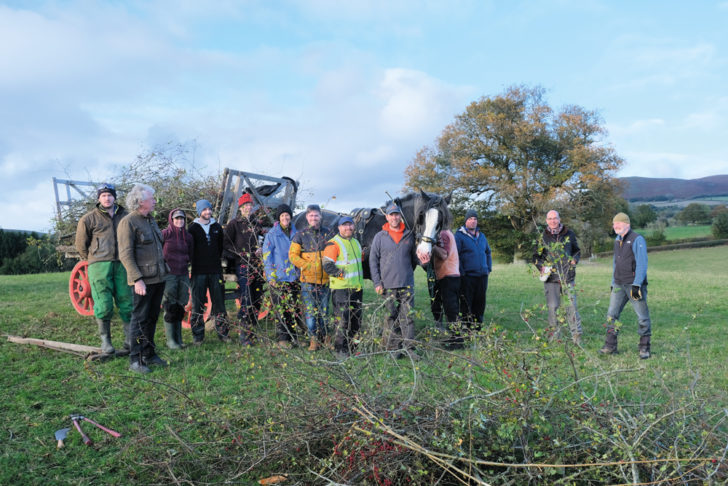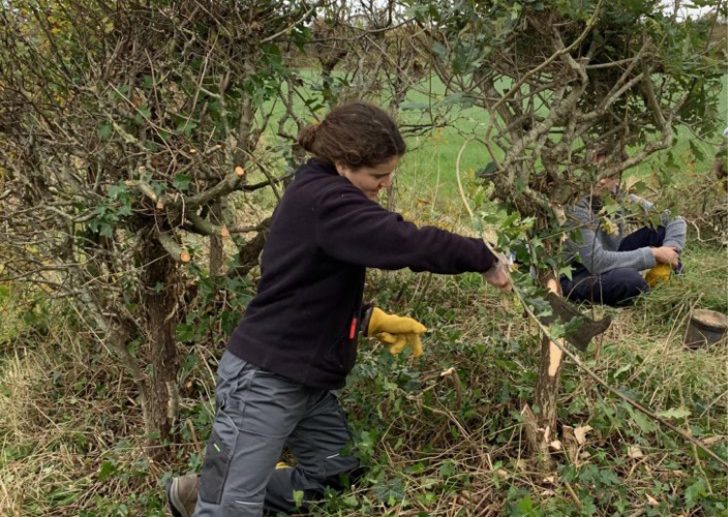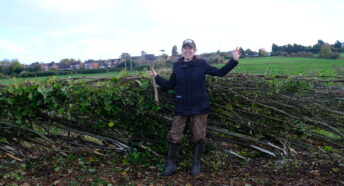Reviving local hedgerows
During winter 2021-22 CPRE helped communities around England revive their hedgerows to benefit landscapes, wildlife and the environment. Here, we meet some of the local volunteers who got involved.
‘I remember flying into England once and looking down over the patchwork quilt of fields that, for as long as I can remember, have defined the landscape for me,’ says hedgerow volunteer David Booker in Shropshire. ‘There is something utterly unique about the cubism of that design.’
As David rightly notes, hedgerows are an iconic part of the English countryside. But the humble hedgerow is much more than an attractive landscape feature and living livestock pen. It’s a home to flora and fauna, including 109 of our most endangered species, and a vital defence against soil erosion, flooding and global warming. That’s why CPRE is calling on the government to increase hedgerow cover by 40% by 2050.
‘This is the recommendation of the UK Climate Change Committee to help achieve net zero,’ explains Emma Marrington, CPRE’s rural communities enhancement lead. ‘Our research shows it would also support 25,000 full-time equivalent jobs in hedge planting, restoration and management. It’s a huge opportunity.’
To support this goal, several CPRE county groups have been running inspiring projects to restore and revive local hedgerows. Through partnerships with local environmental organisations, volunteer teams, landowners and schools, they’re making a tremendous difference to the quality and quantity of English hedgerows. In the process, they’re improving landscapes, increasing biodiversity – and transforming lives, too.

Making hedgerows a hot topic
David took his first steps towards becoming a ‘hedgerow hero’ in November 2021, taking part in a hedgelaying workshop run by CPRE Shropshire on the Acton Scott Estate, home to a historic working farm in the Shropshire Hills. ‘I didn’t realise then the impact those two days would have on my life and the community where I live,’ he says.
David was part of a group of 12 volunteers learning the basics of hedgelaying – namely pleaching, the ancient skill of interlacing flexible young tree shoots to create an impenetrable barrier. The workshop was part of CPRE Shropshire’s wide-ranging programme of hedgerow events. These have included online talks and guided walks covering tree identification, foraging and hedge management, as well as the hedgerow creation and restoration sessions.

Justin Powell of non-profit green enterprise Trees for Shropshire partnered with the project on its volunteer planting days. ‘We’ve planted about 12,000 hedge whips in south Shropshire through CPRE,’ he says. ‘That’s about 2km of hedge over around 20 days of planting in total.’
After completing his first hedgelaying workshop, David set about pleaching a previously scruffy old hazel hedge scarred with corrugated boards and scrap metal. The restored hedge has become a topic of conversation in the local pub. ‘The talk now is of hedgerows and the right way to manage them,’ he says. ‘I’ve given out leaflets and booklets, had doorstep chats and even tried to get the vicar interested after she discussed global warming in a sermon.’
Inspiring the next generation
Almost 200 miles south, recent graduate Ellie Banks is a volunteer for CPRE Hampshire’s hedgerow project – a collaboration with the Meyrick Estate on the western edge of the New Forest. Estate workers, CPRE staff and an enthusiastic team of volunteers have been planting a new 1.7km hedgerow along historical boundaries and ‘gapping up’ 1.3km of existing hedgerow.
Ellie began volunteering for local environmental groups to kick-start a career in conservation. ‘Someone sent me the link to the local hedgerow heroes project on Facebook. It seemed really varied and a great opportunity to learn some new skills,’ she says.
Varied is an understatement. Ellie has been conducting surveys of bumblebees and butterflies, soil sampling, learning about plant identification and using trail cameras to monitor wildlife – all to assess the health of Hampshire hedgerows. She has set up data input and communications channels, written articles and worked with estate managers, funders, ecologists and contractors. Along the way, she’s also learned traditional hedgelaying skills, becoming a dab hand with an axe, Yorkshire hook and mattock. ‘I’d never even planted a tree before!’ she laughs.

Recently, Ellie has been passing her new skills on to the next generation through a hedge-planting workshop at Bransgore Primary School. Working with CPRE staff and the Meyrick Estate manager, she helped pupils plant a new hedge in an estate field next to the school.
‘It was lovely working with those kids. They’d already done some forest schooling, so they were really keen.’ As well as learning about hedgerow plants and wildlife, each child signed CPRE Hampshire’s ‘Hedge Pledge’ to look after hedges and received a picture book, The Happy Hedgerow.
Mapping landscape improvements
Over in Oxfordshire, our county group has partnered with local charity Wild Oxfordshire to plant new hedgerows and rejuvenate ancient ones across the area. Working with community groups and parish councils in Kidlington, Watlington and Eynsham, their efforts have also attracted support from environment secretary George Eustice, who recently planted a tree at one of the project sites.
Volunteer Charlotte Moss got involved after attending a village hall meeting hosted by Watlington Climate Action Group and Watlington Environment Group. ‘One of the speakers was Nigel Adams, an international hedgelaying expert who happens to live locally. His talk was a catalyst for starting to survey the hedges in Watlington,’ she says. ‘I have a background in geographic information systems and thought that might be useful in the project. So I came on board for the initial mapping exercise.’
With the mapping complete, Charlotte and her fellow volunteers have been assessing local hedges using a survey developed by the People’s Trust for Endangered Species. ‘You describe the hedgerow – how tall, how thick, what species are living there – and then give it an overall health score,’ she explains. ‘Ten of us regularly went out in pairs all over the parish. It’s been fascinating cataloguing them all.’

Charlotte has also been on a hedgelaying course and done some planting, all supported by CPRE. ‘So far I’ve laid about five metres,’ she reports. ‘It’s slow going, but I’m sure I’ll speed up as my skills improve!
‘What’s also nice about this project is being able to talk to landowners and suggest improvements, on the back of the survey results. Some landowners are very interested in doing the right thing environmentally. One has already planted a huge amount of hedge based on what we discussed. It’s been really positive.’
A voice for nature
CPRE Gloucestershire is working in partnership with the Farming and Wildlife Advisory Group South West (FWAGSW), Friends of the Cotswolds and local landowners to plant and restore new hedges across the county.
Lee Evans has been volunteering with local tree and hedge-planting schemes around Cirencester since 2018. ‘We’re losing nature in our lives and our landscapes, and I wanted to do something about restoring that.
‘I became aware of CPRE’s work through FWAGSW. I thought it sounded like a great initiative – a chance to put more nature back,’ he continues. ‘We put one hedgerow in near Bibury, and some trees up by Sudeley Castle, and we were recently at Woodcock Farm by Owlpen.’

Lee, a counsellor and mindfulness practitioner, has been involved in numerous community hedge and tree projects across the county and even set up a Facebook group to bring like-minded people together. ‘There are lots of little groups doing lots of little things, but these little bits all add up,’ he notes.
‘What’s been so nice over the past year is that collaboration is making a real difference. I think the greater the collective voice when it comes to reversing the loss of biodiversity, and the more we promote nature, the more chance it has of returning – which can only be a good thing.’
Community connections
Meanwhile, at a national level, CPRE is continuing to push for a government target to increase the extent of hedgerows by 40% by 2050. ‘The local CPRE groups, and the partners they’re working with on the fantastic hedgerow projects, are supporting this national campaigning while developing best practice in planting and restoration, and engaging communities in a positive way,’ says Emma Marrington. ‘The success of all these projects shows what can be done when communities come together.’
With hedge planting and hedgelaying generally taking place from November to February, what has kept our volunteer hedgerow heroes turning up in the coldest, wettest months?
‘When you spend a day planting trees or hedges together, it’s a great experience,’ says Lee. ‘It’s hard work, it’s physical, you’re out in the elements. There’s a great energy; it feels like you’re doing something to make a difference, which is empowering.’
He also loves the diversity of people involved. ‘It’s great when parents bring their kids and they get involved as well. There’s something special about them planting a tree or hedge and knowing it will be there for their entire future – and maybe long beyond.’
Charlotte is proud of her new skills in plant identification, and enjoys the social side of being a hedgerow volunteer. ‘It’s been nice to have a new reason to spend time outside, especially with all the restrictions of the past couple of years, and to chat with other people interested in hedges for all sorts of reasons.’
‘For me, it’s about the needs of the soil, about ecology and biodiversity, carbon capture and nature corridors. But most of all it’s about community,’ says David. ‘Each person we talk to talks to someone else, and word of mouth is powerful among the landowners around here.’
‘It’s coming together and connecting to make an impact,’ agrees Lee. ‘It’s the metaphor of the hedgerow.’
Find out the latest on our #40by50 hedgerow campaign.
A version of this article was originally published in CPRE’s award-winning magazine, Countryside Voices. You’ll have Countryside Voices sent to your door three times a year, as well as access to other benefits including discounts on attraction visits and countryside kit from major high street stores when you join as a CPRE member. Join us now.









